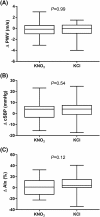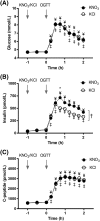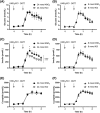Acute interaction between oral glucose (75 g as Lucozade) and inorganic nitrate: Decreased insulin clearance, but lack of blood pressure-lowering
- PMID: 30845346
- PMCID: PMC6595348
- DOI: 10.1111/bcp.13913
Acute interaction between oral glucose (75 g as Lucozade) and inorganic nitrate: Decreased insulin clearance, but lack of blood pressure-lowering
Abstract
Aims: Dietary inorganic nitrate (NO3- ) lowers peripheral blood pressure (BP) in healthy volunteers, but lacks such effect in individuals with, or at risk of, type 2 diabetes mellitus (T2DM). Whilst this is commonly assumed to be a consequence of chronic hyperglycaemia/hyperinsulinaemia, we hypothesized that acute physiological elevations in plasma [glucose]/[insulin] blunt the haemodynamic responses to NO3- , a pertinent question for carbohydrate-rich Western diets.
Methods: We conducted an acute, randomized, placebo-controlled, double-blind, crossover study on the haemodynamic and metabolic effects of potassium nitrate (8 or 24 mmol KNO3 ) vs. potassium chloride (KCl; placebo) administered 1 hour prior to an oral glucose tolerance test in 33 healthy volunteers.
Results: Compared to placebo, there were no significant differences in systolic or diastolic BP (P = 0.27 and P = 0.30 on ANOVA, respectively) with KNO3 , nor in pulse wave velocity or central systolic BP (P = 0.99 and P = 0.54 on ANOVA, respectively). Whilst there were significant elevations from baseline for plasma [glucose] and [C-peptide], no differences between interventions were observed. A significant increase in plasma [insulin] was observed with KNO3 vs. KCl (n = 33; P = 0.014 on ANOVA) with the effect driven by the high-dose cohort (24 mmol, n = 13; P < 0.001 on ANOVA; at T = 0.75 h mean difference 210.4 pmol/L (95% CI 28.5 to 392.3), P = 0.012).
Conclusions: In healthy adults, acute physiological elevations of plasma [glucose] and [insulin] result in a lack of BP-lowering with dietary nitrate. The increase in plasma [insulin] without a corresponding change in [C-peptide] or [glucose] suggests that high-dose NO3- decreases insulin clearance. A likely mechanism is via NO-dependent inhibition of insulin-degrading enzyme.
Keywords: blood pressure; cardiology; cardiovascular; nitric oxide; nutrition; physiology.
© 2019 The British Pharmacological Society.
Conflict of interest statement
A.J.W. holds shares in HeartBeet Ltd, which receive a royalty from James White Drinks Ltd who manufacture beetroot juice (source of dietary nitrate). The other authors have stated explicitly that there are no conflicts of interest in connection with this article.
Figures








Similar articles
-
Inorganic Nitrate Supplementation in Young and Old Obese Adults Does Not Affect Acute Glucose and Insulin Responses but Lowers Oxidative Stress.J Nutr. 2016 Nov;146(11):2224-2232. doi: 10.3945/jn.116.237529. Epub 2016 Oct 12. J Nutr. 2016. PMID: 27733522
-
Inorganic nitrate ingestion improves vascular compliance but does not alter flow-mediated dilatation in healthy volunteers.Nitric Oxide. 2012 May 15;26(4):197-202. doi: 10.1016/j.niox.2012.01.004. Epub 2012 Jan 20. Nitric Oxide. 2012. PMID: 22285857 Free PMC article. Clinical Trial.
-
Inorganic nitrate supplementation lowers blood pressure in humans: role for nitrite-derived NO.Hypertension. 2010 Aug;56(2):274-81. doi: 10.1161/HYPERTENSIONAHA.110.153536. Epub 2010 Jun 28. Hypertension. 2010. PMID: 20585108 Clinical Trial.
-
The role of inorganic nitrate and nitrite in cardiovascular disease risk factors: a systematic review and meta-analysis of human evidence.Nutr Rev. 2018 May 1;76(5):348-371. doi: 10.1093/nutrit/nuy005. Nutr Rev. 2018. PMID: 29506204
-
Effectiveness of dietary inorganic nitrate for lowering blood pressure in hypertensive adults: a systematic review.JBI Database System Rev Implement Rep. 2019 Mar;17(3):365-389. doi: 10.11124/JBISRIR-2017-003842. JBI Database System Rev Implement Rep. 2019. PMID: 30870330
Cited by
-
A randomised, factorial trial to reduce arterial stiffness independently of blood pressure: Proof of concept? The VaSera trial testing dietary nitrate and spironolactone.Br J Clin Pharmacol. 2020 May;86(5):891-902. doi: 10.1111/bcp.14194. Epub 2020 Feb 22. Br J Clin Pharmacol. 2020. PMID: 31833569 Free PMC article. Clinical Trial.
-
The Association between Food Groups, Nutraceuticals, and Food Supplements Consumption on Vascular Health Outcomes: A Literature Review.Life (Basel). 2024 Sep 23;14(9):1210. doi: 10.3390/life14091210. Life (Basel). 2024. PMID: 39337992 Free PMC article. Review.
-
Acute Effects of Inorganic Nitrate Intake on Brachial and Femoral Flow-Mediated Vasodilation, and on Carotid Artery Reactivity Responses: Results of a Randomized, Double-Blinded, Placebo-Controlled Cross-Over Study in Abdominally Obese Men.Nutrients. 2022 Aug 29;14(17):3560. doi: 10.3390/nu14173560. Nutrients. 2022. PMID: 36079817 Free PMC article. Clinical Trial.
-
Influence of acute dietary nitrate supplementation timing on nitrate metabolism, central and peripheral blood pressure and exercise tolerance in young men.Eur J Appl Physiol. 2024 May;124(5):1381-1396. doi: 10.1007/s00421-023-05369-z. Epub 2023 Dec 2. Eur J Appl Physiol. 2024. PMID: 38040982 Free PMC article. Clinical Trial.
-
Association of Urinary Nitrate With Diabetes Complication and Disease-Specific Mortality Among Adults With Hyperglycemia.J Clin Endocrinol Metab. 2023 May 17;108(6):1318-1329. doi: 10.1210/clinem/dgac741. J Clin Endocrinol Metab. 2023. PMID: 36576885 Free PMC article.
References
-
- Larsen FJ, Weitzberg E, Lundberg JO, Ekblom B. Effects of dietary nitrate on oxygen cost during exercise. Acta Physiol (Oxf). 2007;191(1):59‐66. - PubMed
-
- Bailey SJ, Winyard P, Vanhatalo A, et al. Dietary nitrate supplementation reduces the O2 cost of low‐intensity exercise and enhances tolerance to high‐intensity exercise in humans. J Appl Physiol (1985). 2009;107(4):1144‐1155. - PubMed
Publication types
MeSH terms
Substances
Grants and funding
LinkOut - more resources
Full Text Sources
Medical

